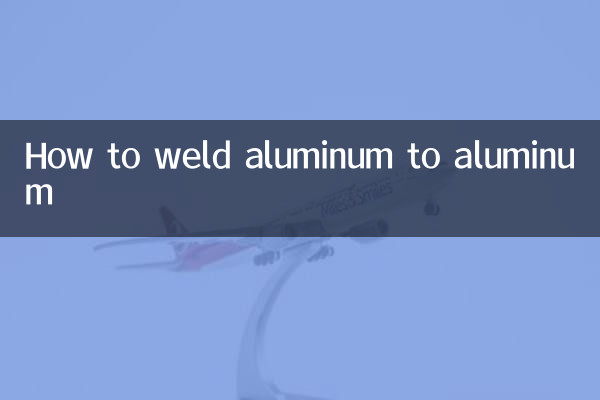How to weld aluminum to aluminum: technical points combined with hot topics on the Internet
In recent years, aluminum and its alloys have been increasingly used in industry, construction, aerospace and other fields, and aluminum welding technology has also become a hot topic. This article will combine the hot content of the entire network in the past 10 days to introduce in detail the welding methods, common problems and solutions of aluminum and aluminum, and attach structured data for reference.
1. Difficulties and hot discussions in aluminum welding

Aluminum has active chemical properties, easily forms an oxide film on its surface, and has high thermal conductivity. These characteristics make aluminum welding difficult. Recent discussions on aluminum welding on social platforms have mainly focused on the following issues:
| Popular questions | Discussion popularity (index) | main focus |
|---|---|---|
| Aluminum welding cracking | 85 | Weld strength and heat affected zone control |
| Welding deformation of thin aluminum plate | 78 | Process parameters, fixture design |
| Dissimilar aluminum alloy welding | 72 | Material matching, filler metal selection |
2. Common methods of aluminum and aluminum welding
According to recent data analysis from technology forums and video platforms across the Internet, the following are the mainstream methods of aluminum welding:
| Welding method | Applicable scenarios | Advantages | limitation |
|---|---|---|---|
| TIG welding (tungsten inert gas welding) | Thin plate, precision welding | High weld quality and small deformation | High technical requirements for operators |
| MIG welding (melting inert gas shielded welding) | Medium and thick plates, mass production | High efficiency and high degree of automation | Large investment in equipment |
| laser welding | High-precision, automated production line | Small heat input and minimal deformation | Equipment costs are extremely high |
3. Practical points of aluminum welding
Based on the content of recent popular welding teaching videos, the following key technical points are summarized:
1.surface treatment: The oxide film on the aluminum surface must be completely removed. It is recommended to use a stainless steel brush or chemical cleaning agent. A recent video blogger’s actual measurement showed that the failure rate of untreated welding is as high as 60%.
2.Shielding gas selection: Pure argon is the general choice, but 30% helium can be added to thick plates to increase penetration. Test data from a certain factory show that an argon-helium mixture can increase welding speed by 20%.
3.Parameter settings: Adjust the current and wire feed speed according to the thickness of the plate. The parameter reference table shared by recent industry forums is as follows:
| Aluminum plate thickness (mm) | TIG welding current (A) | MIG welding voltage (V) | Welding speed (cm/min) |
|---|---|---|---|
| 1.0 | 40-60 | 16-18 | 30-40 |
| 3.0 | 120-150 | 20-22 | 20-30 |
| 6.0 | 180-220 | 24-26 | 15-20 |
4. Recent innovations in aluminum welding technology
According to industry media reports, the following new technologies have attracted attention in the past 10 days:
1.Friction stir welding (FSW): A car company announced that it will apply FSW technology to the production of aluminum alloy battery packs, increasing the welding strength by 15%.
2.Cold Metal Transfer (CMT) Technology: Especially suitable for 0.3-3mm thin plate welding. The heat input is 30% lower than traditional MIG. It is widely used in the field of consumer electronics.
3.Digital welding system: A brand’s newly launched welding machine has a built-in aluminum alloy welding expert database that can automatically match the welding parameters of more than 300 aluminum alloys.
5. Solutions to common problems
For the most frequently asked questions by users recently, we provide the following solutions:
| Problem phenomenon | Possible reasons | solution |
|---|---|---|
| There are pores in the weld seam | Insufficient protective gas/material contamination | Check the gas path and increase the gas flow |
| Burst during welding | Material contains moisture | Preheat at 100-150℃ before welding |
| Melt pool instability | Reverse polarity/inappropriate parameters | Confirm DCEN polarity and adjust parameters |
6. Safety precautions
A recent welding accident has caused heated discussion. Special reminder:
1. Aluminum welding produces a large amount of ultraviolet rays and ozone, and professional masks and ventilation equipment must be used.
2. Aluminum dust is explosive, the work area needs to be cleaned regularly, and open flames are prohibited.
3. The material composition needs to be confirmed before welding. Some aluminum alloys (such as magnesium) are difficult to extinguish when burning.
By combining the latest industry trends and technical points, this article systematically introduces the key technologies of aluminum and aluminum welding. With the development of new materials and new processes, aluminum welding technology will continue to innovate. It is recommended that practitioners pay attention to industry trends and continuously improve their skills.

check the details

check the details